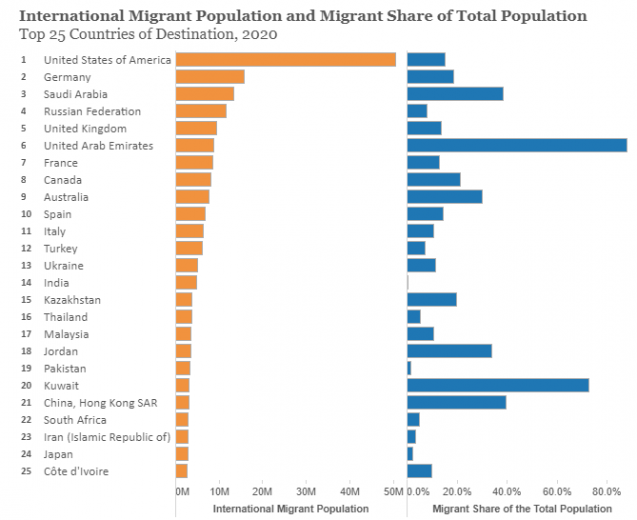The number of international migrants worldwide is steadily growing. People move to other countries for political, economic, and other reasons. In contrast to the previous years, today we have relocation systems, developed infrastructure, and other measures that facilitate the migration processes. The UN found that the number of migrants stood at 281 million in 2020. The graphics below is based on the data of the Migration Policy Institute and shows that the most popular destinations for migrants are the United States, Germany, and Saudi Arabia.

Migration has both advantages and disadvantages. For example, migrants have a good impact on the economy by bringing different skills to the market and increasing productivity. This, in turn, facilitates the growth in the average income of the local population. For example, the German Institute for Economic Research revealed that foreign workers significantly boosted the country’s GDP growth.
However, there is the other side of the coin that relates to language integration. Unfortunately, it’s a common situation when foreigners don’t know and don’t learn the language of their new home and communicate only with their ex-countrypeople. This leads to the formation of multilingual environments in the countries and misunderstanding in various spheres. According to the US Census Bureau, 8.6% of residents don’t speak English. By the way, there are more than 350 languages being circulated in the country! As for Germany, the second popular destination among immigrants, almost 50% of immigrants fail language tests.
In our article, we’ll speak about language problems in healthcare and how they can be overcome using digital solutions.
Language Barriers and Communication Failures in Healthcare
Medical professionals are unable to provide effective services to patients due to language barriers and misunderstandings. Problems can arise when a patient applies to a medical institution and needs to fill out documents. If the patient doesn’t know the language, he/she won’t be able to fill out the questionnaire correctly. If patients fill it out in their own languages, the medical staff won’t be able to read it and obtain the necessary information about the patient’s health.
The next problem is that the patient won’t be able to explain the symptoms, and the doctor won’t be able to prescribe adequate treatment. The physician will have to make a decision about which treatment option to follow for the patient, while the patient must understand and be aware of the potential risks and benefits of all options. There is also a risk of misdiagnosis as the physician may miss critical information and misinterpret symptoms due to misunderstanding. There are also risks of prescribing the wrong drugs, which can cause allergic reactions and even be fatal.
Some studies demonstrated that 49% of patients who can’t speak the local language were unable to discuss their condition with a doctor. Moreover, almost 35% didn’t understand how to use meds, while 41.8% couldn’t read the package leaflet. What’s more dangerous, almost 16% of patients suffered from adverse reactions because they didn’t understand how to use their medications.
For example, doctors could not help a 62-year-old Hispanic patient for a long time because she spoke poor English and refused the services of an interpreter every time she applied to the medical institution. She suffered from hypertension and her condition didn’t improve despite various medications and treatment options. She has visited various doctors for 2 years, but they could not help her.
As it turned out, the reason was that she misinterpreted the treatment due to poor language skills. She took medication only when she was stressed, while she needed to take drugs on a regular basis. Finally, the doctors managed to explain to the patient that she must take hypertension medicines every day. As we can see, the patient has suffered for 2 years due to the fact that she couldn’t understand the doctor’s appointment. This story has a happy ending as the woman got the chance to improve her health state.
The South Florida case had more horrible consequences. The unconscious patient was brought to the hospital by his Spanish-speaking relatives. They wanted to say to the medical staff that he was nauseous and used the word “intoxicado.” The doctors thought that he was intoxicated and made an incorrect diagnosis, which resulted in quadriplegia and a ruined life. What are medical professionals doing now to solve the misunderstanding issue?
Measures Taken Now to Remove Language Barriers in Healthcare
By the way, WHO is concerned with the problem of multilingualism in healthcare and making efforts to overcome it. For instance, health officials recommend using the services of a professional interpreter or translator. But this option entails other issues: interpreters may not be available, their services may be too expensive, or not covered by health insurance. The Canadian researchers found that 26.4% of limited English proficiency patients had no access to interpretation services because there were no such specialists in their healthcare facilities. Also, the presence of a third person can adversely affect the communication between the patient and the doctor. The patients may feel stressed from having to share their concerns with more than just a healthcare professional.
Another recommendation is to hire bilingual or multilingual medical staff but sometimes it can be impossible to find a candidate with the right language skills. One more way is to provide language training for the medical staff but it requires time and money. These steps help doctors increase the level of trust between them and patients and improve the general takeaway from the medical institution.
At the same time, we should not forget that we live in the age of digital technologies that can effectively solve many of our problems, including communication and language barriers. When some medical facilities are looking for bilingual nurses and doctors, others are using different apps designed to help healthcare professionals and people to clearly understand each other.
How Interpreting Apps Make Communication in Healthcare Effective
So, the easiest and free option to help medical care providers and non-native English speakers improve communication is Google Translate. Researchers found that this tool increases the quality of healthcare delivery and patient satisfaction. Taking into account the fact that today there are more than 6 billion smartphone users in the world, they should not have problems accessing this service. There are other solutions in the market that can help healthcare professionals and patients communicate effectively.
For example, UCSF medical students developed MediBabble, a free translation app that contains a number of questions in various languages. Imagine that a Spanish-speaking patient comes to the hospital where no one can speak Spanish and an interpreter is unavailable. Using this app, doctors can ask important questions and establish the right diagnosis. The questions were prepared by physicians and translated into various languages by professional medical translators.
Another interpreting app – Canopy Speak – was brought to the market by the US company Canopy Innovations. The app is available in several languages, such as Spanish, French, Russian, Japanese, Chinese, and more. It can translate more than 4,000 medical phrases by playing them with video or showing with written translations. If required, patients can get in touch with a medical interpreter with just one click.
In addition to translation applications, video remote interpreting platforms are gaining popularity as well. This service is successfully used by the University Medical Center Hamburg-Eppendorf. It connects non-German speaking patients and their doctors with a professional medical translator within 120 seconds to reveal the problem as soon as possible and assign a therapy.
There are also solutions that can help patients who can’t speak at all due to their condition. VerbalCare is a mobile app that was created for people with aphasia to allow them to call a nurse. There are various icons on the screen that can be sent to the doctor with some information, such as « I can’t breathe » or something like that.
Language barriers should not prevent patients from receiving qualified medical care. Therefore, it’s important to provide applications that can close these gaps and help healthcare professionals and patients find common ground. What should this app be like? At least, convenient, effective, and secure. When developing these services, you must always remember about security because they deal with personal data. Make sure that your mobile app complies with HIPAA standards that protect people’s personal health information.
Elinext experts know how to bring such solutions to the market. Do you want to create a similar service? Our specialists are ready to turn your idea into reality.









